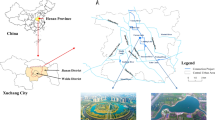Abstract
Korea government has pursued the urban stream restoration project “Cheonggyecheon Plus 20” aiming restore paved streams in cities by the same manner as the Cheonggyecheon (or Cheonggye Stream) restoration project in Seoul. This study evaluated the ultimate economic effect of the Cheonggyecheon restoration by applying an ex-post cost benefit analysis using actual data, such as project expenses and maintenance costs. Comparing this ex-post analysis with the ex-ante analysis conducted before the project was launched, it was found that the costs were larger than expected because the traffic congestion caused by the project had been underestimated. The benefits were lower than anticipated because the restored Cheonggyecheon was not identical to the original stream, contrary to the expectations of citizens who had based their willingness to pay for the project on the return of the stream to its natural state. As a result, the benefit-cost ratio of the project at its completion was calculated to be 0.75, much lower than the 1.89 produced in the ex-ante analysis. This study suggests that other urban stream restoration projects should prepare more accurate plans to minimize negative impacts on traffic and try to restore the streams to as natural a state as possible.
Similar content being viewed by others
References
Boardman, A. E., Greenberg, D., Vining, A., and Weimer, D. (2011). Cost-benefit analysis: concepts and practices, Pearson Education.
Bohara, A. K., Jerkvliet, J., and Berrens, R. P. (2001). “Addressing negative willingness to pay in dichotomous choice contingent valuation: A monte carlo simulation.” Environmental and Resource Economics, Vol. 20, No. 3, pp. 173–195, DOI: 10.1023/A:1012642902910.
Cho, W.-Y. (2009). Estimation of ecological restoration projects using progressive response survey, Dept. of Urbanand Regional Planning, Yonsei University, Seoul.
Choi, J. K., Byeon, H. K., Kwon, Y. S., and Park, Y. S. (2008). “Spatial and temporal changes of fish community in the cheonggye stream after the rehabilitation Project.” Vol. 41, No. 3, pp. 374–381.
Chung, J.-H., Hwang, K. Y., and Bae, Y. K. (2012). “The loss of road capacity and self-compliance: Lessons from the Cheonggyecheon stream restoration.” Transport Policy, Vol. 21, pp. 165–178.
Downing, M. and Ozuna, T. Jr. (1996). “Testing the reliability of the benefit function transfer approach.” Journal of Environmental Economics and Management, Vol. 30, No. 3, pp. 316–322, DOI: 10.1006/jeem.1996.0021.
Han, S.-H. (2005). A study on integrated conflict management: the case of the cheonggye stream restoration project, Department of Public Administration, Dankook University, Seoul.
Hwang, P. S. (2006). A study on the preventive conflict-management of public works: Focused on the restoration project of chonggyecheon, Department of Public Administration, Kyung-Hee University, Seoul.
Jang, Y. K., Kim, J., Kim, H. J., and Kim, W. S. (2010). “Analysis of air quality change of cheonggyecheon area by restoration Project.” Korean Society of Environmental Impact Assesment, Vol. 19, No. 1, pp. 99–106.
Jo, M. H., Jo, Y. W., and Kim, S. J. (2009). “The application of ASTER TIR satellite imagery data for surface temperature change analysis-a case study of cheonggye stream restoration project.” The Korean Association of Geographic Information Studies, Vol. 12, No. 1, pp. 73–80.
Kang, J.-Y. (2009). A study on the public conflict management in the process of the chonggyechon restoration project, Graduate School of Public Administration, Seoul National University, Seoul.
KDI (2008). A study on standard guidelines for pre-feasibility study on water resource projects (4th Edition), Korea Development Institute (KDI) Seoul.
Kim, H. and Kim, H. J. (2008). Cheonggyecheon water quality and ecology monitoring, Environment Landscape Architecture, pp. 50–59.
Kim, H. G. and Koo, B. H. (2010). Floral changes during three years after cheonggyecheon restoration, Vol. 13, No. 6, pp. 107–115.
Kim, H. J., Kim, S. H., and Kim, S. Y. (2006). “Changes in mater quality, flora and vegetation of cheonggye stream before, during and after its restoration.” Korean Society of Environment & Ecology, Vol. 20, No. 2, pp. 235–256.
Lee, I. K. (2006). Cheonggyechoen restoration proejct, ICLEI World Congress 2006, Capetown International Convention Centre, South Africa.
Lee, J. Y. (2006). A Study on the conflict management: Comparing the cases of cheonggyecheon restoration project and locating nuclear waste facility in Buan, Department of Public Policy, Ewha Womans University, Seoul.
Lee, M. and Jung, I. (2012). “Development of ex-post cost benefit criteria and analysis plan for an Urban stream restoration project: the case of cheonggyecheon restoration project.” Environmental Policy Research, Vol. 11, No. 3, pp. 67–96.
Lee, Y.-S., Kim, W.-S., and Hwang, K.-Y. (2007). “Differences in different socio-economic groups willingness-to-pay for cheonggyechon restoration project and policy implications.” Seoul City Research, Vol. 8, No. 3, pp. 105–115.
Park, J., Lee, H., and Kim, K. H. (2010). A Study for the post evalustion method of transport investment: Focusing on surface transport, Korea Transport Institute, Goyang.
Rhee, J.-J. (2000). Land & environment economics, Parkyoungsa, Seoul.
Seoul Development Institute (2003). Feasiblity study and basic plan for cheonggychen restoration project Seoul.
Seoul Metropolitan Government (2006). Cheonggyecheon resotration project white paper, Seoul Metropolitan Government, Seoul.
Author information
Authors and Affiliations
Corresponding author
Rights and permissions
About this article
Cite this article
Lee, M., Jung, I. Assessment of an urban stream restoration project by cost-benefit analysis: The case of Cheonggyecheon stream in Seoul, South Korea. KSCE J Civ Eng 20, 152–162 (2016). https://doi.org/10.1007/s12205-015-0633-4
Received:
Revised:
Accepted:
Published:
Issue Date:
DOI: https://doi.org/10.1007/s12205-015-0633-4




